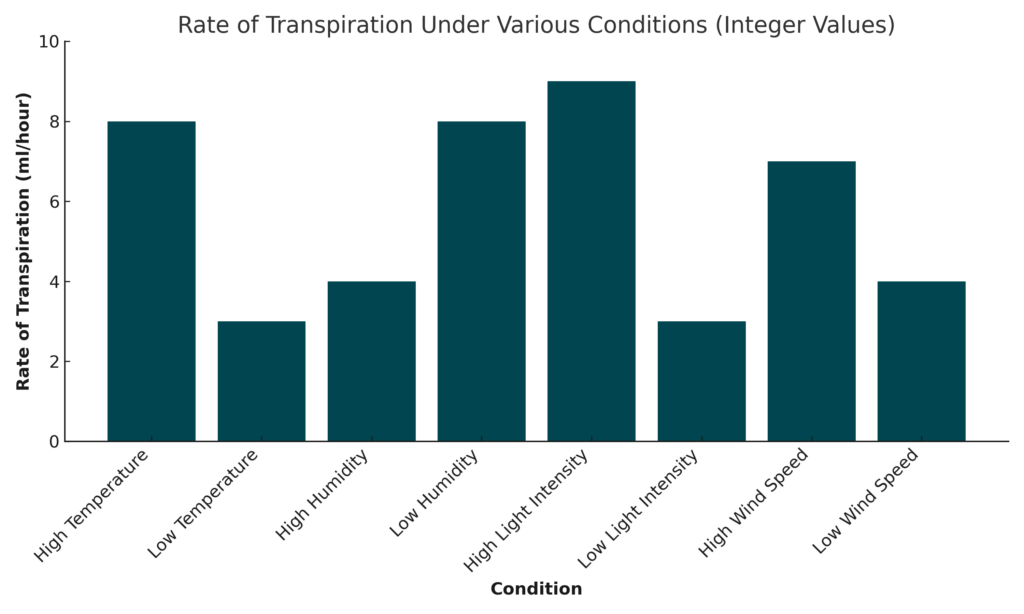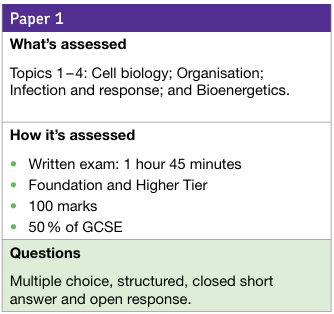Mock test. 100 marks available.
GCSE AQA Biology Paper 1
Quiz Summary
0 of 44 Questions completed
Questions:
Information
You have already completed the quiz before. Hence you can not start it again.
Quiz is loading…
You must sign in or sign up to start the quiz.
You must first complete the following:
Results
Results
0 of 44 Questions answered correctly
Your time:
Time has elapsed
You have reached 0 of 0 point(s), (0)
Earned Point(s): 0 of 0, (0)
0 Essay(s) Pending (Possible Point(s): 0)
| Average score |
|
| Your score |
|
Categories
- Not categorized 0%
- 6 Mark Questions 0%
- Short Answer 0%
- 1
- 2
- 3
- 4
- 5
- 6
- 7
- 8
- 9
- 10
- 11
- 12
- 13
- 14
- 15
- 16
- 17
- 18
- 19
- 20
- 21
- 22
- 23
- 24
- 25
- 26
- 27
- 28
- 29
- 30
- 31
- 32
- 33
- 34
- 35
- 36
- 37
- 38
- 39
- 40
- 41
- 42
- 43
- 44
- Current
- Review
- Answered
- Correct
- Incorrect
-
Question 1 of 44
1. Question
5 point(s)[question number = 01.1] Which sub-cellular structures can be found in animals? (short answer)
Correct 5 / 5 PointsIncorrect / 5 Points -
Question 2 of 44
2. Question
3 point(s)[question number = 01.2] Drag and drop to match the role and structure
Sort elements
- Cytoplasm
- Chloroplasts
- Mitochondria
- Supports and suspends structures within cells and where chemical reactions take place
- Where photosynthesis takes place
- Where aerobic respiration takes place
CorrectIncorrect -
Question 3 of 44
3. Question
3 point(s)[question number = 01.3] Drag and drop to match the role and structure
Sort elements
- Ribosomes
- Cell wall
- Vacuole
- Sites of protein synthesis (where proteins are made)
- Supports the cell providing strength and flexibility for growth
- Stores nutrients and salts
CorrectIncorrect -
Question 4 of 44
4. Question
2 point(s)[question number = 01.4] Palisade cells are found just below the epidermis of leaves. What is their role and how are they adapted to perform it? (short answer)
Correct 2 / 2 PointsIncorrect / 2 Points -
Question 5 of 44
5. Question
5 point(s)[question number = 01.5] The male gametes (sperm cells) are adapted to their function. Describe 5 adaptations of sperm cells. (short answer)
Correct 5 / 5 PointsIncorrect / 5 Points -
Question 6 of 44
6. Question
1 point(s)[question number = 01.6] Use some of the following terms to fill in the blanks:
Chaotic, controlled, peaceful, uncontrolled
-
Cancer cells form when changes in cells lead to cell division
CorrectIncorrect -
-
Question 7 of 44
7. Question
1 point(s)[question number = 01.7] Use some of the following terms to fill in the blanks:
Marigolds, septioids, meristems, endocrines
-
Complete the sentence: Groups of cells in rapidly growing parts of plants, such as the roots and shoots have a special ability to turn into any kind of cell. These groups of cells are called .
CorrectIncorrect -
-
Question 8 of 44
8. Question
2 point(s)[question number = 02.1] Use some of the following words to fill in the blanks:
Amidst, with, against, away from
-
In diffusion and osmosis, particles move the concentration gradient, whilst in active transport, particles move the concentration gradient.
Correct 2 / 2 PointsIncorrect / 2 Points -
-
Question 9 of 44
9. Question
3 point(s)[question number = 02.2] (short answer) Which factors affect the rate of diffusion?
Correct 3 / 3 PointsIncorrect / 3 Points -
Question 10 of 44
10. Question
1 point(s)[question number = 02.3] Multicellular organisms are too large to allow diffusion through their cells to provide the necessary resources. Instead we have transport systems. What is the name of the transport system that uses capillaries to transport substances via the blood? (short answer)
CorrectIncorrect -
Question 11 of 44
11. Question
4 point(s)[question number = 02.4] Drag and drop to match the function to the correct part of blood
Sort elements
- Plasma
- White blood cells
- Red blood cells
- Platelets
- Carrying dissolved substances around the body
- Protecting the body from foreign cells
- Carrying oxygen around the body via haemoglobin
- Healing wounds by clotting the blood
CorrectIncorrect -
Question 12 of 44
12. Question
4 point(s)[question number = 02.5] (short answer) Describe the role and structure of veins
Correct 4 / 4 PointsIncorrect / 4 Points -
Question 13 of 44
13. Question
2 point(s)[question number = 02.6] Capillaries are only one cell thick and have thousands of branches. What is the function of capillaries? (short answer)
Correct 2 / 2 PointsIncorrect / 2 Points -
Question 14 of 44
14. Question
1 point(s)[question number = 02.7] If coronary arteries are blocked, new blood vessels can be inserted, what is this procedure called? (short answer)
CorrectIncorrect -
Question 15 of 44
15. Question
1 point(s)[question number = 02.8] What are the upper chambers of the heart called? (short answer)
CorrectIncorrect -
Question 16 of 44
16. Question
2 point(s)[question number = 03.1] Use some of the following words to fill in the blanks:
Companion, guard, root hair, translocation, transpiration
-
Complete the statement: During sucrose is transported in the sieve tubes of phloem vessels. cells pump sucrose across sieve cells up shoots or down to storage organs.
Correct 2 / 2 PointsIncorrect / 2 Points -
-
Question 17 of 44
17. Question
3 point(s)[question number = 03.2] Use some of the following words to fill in the blanks:
Phloem, xylem, guard cells, stream, stomata, root hair cells, hoses
-
Complete the statement: Water is pulled up the vessels as water evaporates from the vessels in the leaves. As the water vapour diffuses through the more water evaporates from the vessels. This creates a continuous chain of water called the transpiration .
Correct 3 / 3 PointsIncorrect / 3 Points -
-
Question 18 of 44
18. Question
5 point(s)[question number = 03.3] Look at the graph below:
Fill in the table below based on the graph.
-

Condition Rate of Transpiration (ml/hour) High Temperature 8 Low Temperature 4 Low Humidity 9 Low Light Intensity 3 High Wind Speed Low Wind Speed 4
CorrectIncorrect -
-
Question 19 of 44
19. Question
1 point(s)[question number = 03.4] Use some of the following words to fill in the blanks:
Xylem, phloem, guard cells, root hairs
-
Living cells in use energy to transport sucrose around the plant.
CorrectIncorrect -
-
Question 20 of 44
20. Question
1 point(s)[question number = 04.1] What is the balanced chemical equation for photosynthesis?
CorrectIncorrect -
Question 21 of 44
21. Question
5 point(s)[question number = 04.2] (short answer) One of the products of photosynthesis is glucose. Describe the uses of glucose produced during photosynthesis.
Correct 5 / 5 PointsIncorrect / 5 Points -
Question 22 of 44
22. Question
3 point(s)[question number = 04.3] Which of the following are 3 of the adaptations of leaves for efficient photosynthesis?
Correct 3 / 3 PointsIncorrect / 3 Points -
Question 23 of 44
23. Question
6 point(s)[question number = 04.4] The rate of photosynthesis in pondweed can be affected by temperature. Describe a method you could use to investigate the effect of temperature on the rate of photosynthesis. (enter your answer)
You should include:
- how you would set up the apparatus and the materials you would use
- the measurements you would make
- how you would control other variables.
Correct 6 / 6 PointsIncorrect / 6 Points -
Question 24 of 44
24. Question
1 point(s)[question number = 05.1] Use one of the following words to fill in the blank:
Microbe, pathogen, insect, pest-
Complete the sentence. A is a disease-causing organism.
CorrectIncorrect -
-
Question 25 of 44
25. Question
1 point(s)[question number = 05.2] How do antibiotics work?
CorrectIncorrect -
Question 26 of 44
26. Question
1 point(s)[question number = 05.3] Which of the following are physical barriers stopping pathogens from entering the body?
CorrectIncorrect -
Question 27 of 44
27. Question
3 point(s)[question number = 05.4] Drag and drop to match the disease with the mode of transmission
Sort elements
- Animal vectors
- Blood exchange/sexual contact
- Infected food
- Malaria
- HIV
- Salmonella
CorrectIncorrect -
Question 28 of 44
28. Question
3 point(s)[question number = 05.5] Drag and drop to match the type of pathogen with the correct disease
Sort elements
- Viruses
- Bacteria
- Protists
- Measles and HIV
- Salmonella
- Malaria
CorrectIncorrect -
Question 29 of 44
29. Question
1 point(s)[question number = 05.6] Place the following statements in the correct order:
- Activated Lymphocytes divide to make clones
- Other lymphocytes stay in the blood and as memory lymphocytes ready to attack the pathogen if it enters the body again)
- Some lymphocytes eject antibodies which stick to the antigens of pathogens and destroy them
- A pathogen enters the body and bypasses the physical and chemical defences
- The lymphocytes with antibodies that match the shape of the antigens on the pathogens are activated
View Answers:
CorrectIncorrect -
-
Question 30 of 44
30. Question
1 point(s)[question number = 05.7] Which of the following is NOT a symptom of plant disease detection?
CorrectIncorrect -
Question 31 of 44
31. Question
1 point(s)[question number = 06.1] What is the purpose of respiration? (short answer)
CorrectIncorrect -
Question 32 of 44
32. Question
1 point(s)[question number = 06.2] In what part of the cells does aerobic respiration take place? (short answer)
CorrectIncorrect -
Question 33 of 44
33. Question
1 point(s)[question number = 06.3] Which system is responsible for ensuring the supply of oxygen and glucose to cells?
CorrectIncorrect -
Question 34 of 44
34. Question
2 point(s)[question number = 06.4] During exercise, your cells require more oxygen and glucose. What changes in the body happen during exercise to meet these increased needs? (short answer)
Correct 2 / 2 PointsIncorrect / 2 Points -
Question 35 of 44
35. Question
1 point(s)[question number = 06.5] What is the difference between aerobic and anaerobic respiration? (short answer)
CorrectIncorrect -
Question 36 of 44
36. Question
1 point(s)[question number = 07.1] Why does the rate of an enzyme-controlled reaction increase with greater substrate concentration?
CorrectIncorrect -
Question 37 of 44
37. Question
1 point(s)[question number = 07.2] After digestion, the products are used to:
CorrectIncorrect -
Question 38 of 44
38. Question
3 point(s)[question number = 07.3] Match the enzyme to its primary function.
Sort elements
- Breaks down starch to simple sugars (maltose)
- Breaks down proteins to amino acids
- Breaks down lipids to glycerol and fatty acids
- Amylase
- Protease
- Lipase
CorrectIncorrect -
Question 39 of 44
39. Question
1 point(s)[question number = 07.4] Arrange the following organs in the order in which food passes through them during digestion.
- Stomach
- Small intestine
- Esophagus
- Mouth
View Answers:
CorrectIncorrect -
-
Question 40 of 44
40. Question
2 point(s)[question number = 07.5] Which of the following are functions of bile?
CorrectIncorrect -
Question 41 of 44
41. Question
1 point(s)[question number = 08.1] Calculate the number of bacteria in a population after 3 hours if the initial population is 200 and the mean division time is 30 minutes.
CorrectIncorrect -
-
Question 42 of 44
42. Question
1 point(s)[question number = 08.2] Express the number of bacteria as 6.4 x 10³ in ordinary form.
CorrectIncorrect -
-
Question 43 of 44
43. Question
6 point(s)[question number = 08.3] (short answer) Describe the key steps and safety considerations when preparing an uncontaminated bacterial culture in a school laboratory
Correct 6 / 6 PointsIncorrect / 6 Points -
Question 44 of 44
44. Question
3 point(s)[question number = 08.4] Use some of the following answers to fill in the blanks:
Nutrients, binary fission, contamination, temperature-
Bacteria grow and multiply by when provided with adequate and suitable .
CorrectIncorrect -
Is this higher or foundation?
This is a combined paper for higher and foundation students. You can achieve grades 1 – 9 on this paper, so it is suitable for all. Grades are moderated against the average result to give the most accurate indication of your performance. You can look at – How is this paper marked? for more information.
How is this paper marked?
This paper is automatically marked to determine which questions were answered correctly.
Your grade is determined using a Z-Score moderation system. Your GCSE exams are also moderated comparably so that the difficulty of papers is taken into account.
Roughly, this works by calculating your overall percentage and comparing it to the average percentage and the standard deviation. This means that for harder papers you need fewer points to get the same grade as you would for an easier paper.
As more students attempt the paper, the average score and standard deviation more accurately represent the difficulty of the paper and the grades become more accurate.
Making these papers and the marking system took considerable effort so if you found them helpful for your revision, please show your appreciation by rating the page.
Which exam board are you studying?


